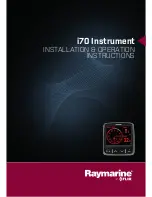
Section 10 – Operations related to timecode
10-6 – 1.00 – 06/97
outputs, whichever set of outputs is in use at the
time.
1) Go to menu group 5, move the cursor to
OutTc Tmg
(output timecode timing) and
press
ENTER
:
2) Use the
UP
and
DOWN
keys to select between
Analog
and
Digital
.
10.4.5 Using MIDI Time Code (MTC)
The DA-98 can output MIDI Time Code in almost
exactly the same way as it outputs audio timecode,
with the following exceptions.
MIDI Time Code can be output either when the
DA-98 is playing, or in fast forward or rewind, or
when stopped. You can turn off the output during
the “fast” modes and while stopped, to avoid over-
loading a MIDI data stream.
1) Go to menu group 7, move the cursor to MTC
Out and press
ENTER
:
2) Use the
LEFT
and
RIGHT
cursor keys to select
the field for which you want to turn MTC on
and off, and the
UP
and
DOWN
keys to turn
MTC on or off.
Note that if the
Output
field is turned
off
,
turning the other fields
on
will have no effect.
10.5 Recording timecode
10.5.1 Selecting the timecode source
The DA-98 allows you to select one of three
sources for recording timecode: the DA-98’s inter-
nal generator, an external source or timecode
based on tape.
To select the source for recording timecode:
1) Go to menu group 8, move the cursor to
TcRec Src
(source for timecode recording),
and press
ENTER
:
2) Use the
UP
and
DOWN
keys to select a source
for the timecode recording from the following
options:
Generator TC
,
Tape
and
External TC
.
If you select
Tape
, the source of the tape time-
code will also be shown, as determined in the tape
timecode selection menu (see 10.2, “Tape time-
code mode”).
If you are recording timecode only, we suggest
that you do not use external sources for recording
timecode.
Set
Tape
as the source as described immediately
above, and use
ABS
or
ABS-Ofs
(see 10.2.2,
“ABS setting” and 10.2.3, “ABS-Ofs setting”) as
tape timecode sources. This will ensure an accu-
rate relationship between the timecode and the
ABS timing reference (the fact that the generator
must be started manually means that there will not
be a tight relation between timecode and the ABS
timing).
This will also allow you to synchronize multiple
DTRS units accurately to external timecode, even
though the slave units are not timecode-based.
10.5.2 Recording timecode using the
generator
1) Insert a formatted tape into the DA-98.
It is possible to format and stripe a new tape simul-
taneously, by setting up the formatting procedure
as described in 6.1, “Formatting a tape” and then
following the instructions below.
O u t p u t
T C
T i m i n g
A n a l o g
M T C
O u t p u t
O u t p u t
F a s t
S t o p
o n
o f f
o f f
T C
R e c o r d
S o u r c e
G e n e r a t o r
T C
NOTE
Generally speaking, timecode should be recorded from
an external source only when audio tracks and timecode
must be transferred together from external units. In all
other cases, we suggest that you use the internal genera-
tor or the tape as sources for recording timecode.
Summary of Contents for DA-98
Page 7: ...Table of Contents TOC 4 1 00 06 97...
Page 13: ...Section 1 Introduction to the DA 98 1 6 1 00 06 97...
Page 19: ...Section 3 Rear Panel connectors 3 2 1 00 06 97...
Page 23: ...Section 4 Connections 4 4 1 00 06 97...
Page 35: ...Section 6 Basic operations 6 8 1 00 06 97...
Page 39: ...Section 7 Monitoring modes 7 4 1 00 06 97...
Page 55: ...Section 9 Synchronization with other DTRS units 9 6 1 00 06 97...
Page 75: ...Section 11 External control 11 6 1 00 06 97...
















































